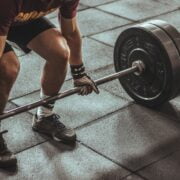
Get Stronger and Leaner with this Calisthenics Upper Body Workout
Calisthenics is a form of exercise that uses bodyweight movements to build strength, flexibility, and endurance. It is a highly effective and versatile training method that can be done anywhere, without the need for expensive equipment or a gym membership. Calisthenics workouts focus on using the muscles in the upper body, including the chest, back, shoulders, and arms.
The benefits of calisthenics workouts are numerous. Firstly, they are a great way to build strength and lean muscle. By using your own bodyweight as resistance, you can effectively target and engage multiple muscle groups at once. This leads to increased muscle mass and improved overall strength.
In addition to building strength, calisthenics workouts also improve flexibility and mobility. Many of the exercises involve dynamic movements that require a full range of motion in the joints. This helps to improve joint health and prevent injuries.
Key Takeaways
- Calisthenics upper body workouts are a great way to build strength and lean muscle without equipment.
- Proper form and technique are crucial to prevent injury and maximize results.
- Warm-up exercises are important to prepare your body for the workout and prevent injury.
- The best calisthenics upper body exercises include push-ups, pull-ups, dips, and handstand push-ups.
- Progression and increasing difficulty are important for continued progress and results.
The Benefits of Calisthenics Training for Strength and Lean Muscle
Calisthenics training is an excellent way to build strength and lean muscle. Unlike weightlifting, which primarily focuses on isolating specific muscles, calisthenics exercises engage multiple muscle groups at once. This leads to more functional strength that can be applied to real-life activities.
In addition to building strength, calisthenics training also promotes lean muscle growth. The combination of bodyweight exercises and high-intensity interval training (HIIT) helps to increase muscle mass while burning fat. This results in a leaner and more toned physique.
Compared to other forms of exercise, such as weightlifting or cardio machines, calisthenics training offers a unique set of benefits. It can be done anywhere, without the need for expensive equipment or a gym membership. This makes it accessible to people of all fitness levels and budgets.
The Importance of Proper Form and Technique
Proper form and technique are crucial when it comes to calisthenics training. Performing exercises with incorrect form can lead to injuries and prevent you from getting the full benefits of the workout.
One common mistake to avoid is using momentum to complete the exercises. This often happens when people try to rush through the movements or use excessive swinging or bouncing. Instead, focus on controlled and deliberate movements, engaging the targeted muscles throughout the entire range of motion.
Another common mistake is neglecting proper alignment and posture. It’s important to maintain a neutral spine and engage the core muscles to support your body during the exercises. This helps to prevent injuries and ensures that you are targeting the intended muscle groups.
To improve your form and technique, start by practicing the exercises slowly and with lighter resistance. Focus on maintaining proper alignment and engaging the correct muscles. As you become more comfortable with the movements, gradually increase the intensity and resistance.
Warm-Up Exercises to Prepare Your Body for the Workout
| Warm-Up Exercise | Description | Benefits |
|---|---|---|
| Jumping Jacks | Jumping while spreading arms and legs apart and then returning to starting position. | Increases heart rate, warms up muscles, improves coordination. |
| High Knees | Running in place while lifting knees up to hip level. | Increases heart rate, warms up leg muscles, improves balance and coordination. |
| Butt Kicks | Running in place while kicking heels up to touch buttocks. | Increases heart rate, warms up leg muscles, improves flexibility. |
| Arm Circles | Standing with arms extended, making circular motions with arms. | Warms up shoulder muscles, improves range of motion. |
| Leg Swings | Standing on one leg and swinging the other leg back and forth. | Warms up hip muscles, improves flexibility and balance. |
Before starting any workout, it’s important to warm up your body to prevent injuries and prepare your muscles for the upcoming exercises. A proper warm-up increases blood flow to the muscles, improves flexibility, and enhances overall performance.
Some examples of warm-up exercises for upper body workouts include arm circles, shoulder rolls, and wrist rotations. These exercises help to loosen up the joints and increase range of motion in the upper body.
Another effective warm-up exercise is push-ups. Start with a modified version, such as knee push-ups or incline push-ups, and gradually increase the difficulty as you warm up. Push-ups engage multiple muscle groups in the upper body and help to activate the core muscles.
To customize your warm-up routine, consider your specific needs and limitations. If you have any existing injuries or mobility issues, incorporate exercises that target those areas. Additionally, if you are planning on performing specific upper body exercises during your workout, include warm-up exercises that mimic those movements.
The Best Calisthenics Upper Body Exercises for Building Strength and Lean Muscle
There are several highly effective upper body exercises in calisthenics that can help you build strength and lean muscle. These exercises target the chest, back, shoulders, and arms, and can be modified to suit your fitness level.
One of the most effective upper body exercises is the push-up. It targets the chest, shoulders, triceps, and core muscles. To perform a push-up, start in a high plank position with your hands slightly wider than shoulder-width apart. Lower your body until your chest is just above the ground, then push back up to the starting position.
Another great exercise is the pull-up. It targets the back, biceps, and shoulders. To perform a pull-up, start by hanging from a bar with your palms facing away from you. Pull your body up until your chin is above the bar, then lower yourself back down with control.
Dips are another effective exercise for the upper body. They target the triceps, chest, and shoulders. To perform a dip, start by gripping parallel bars or using dip bars. Lower your body until your elbows are at a 90-degree angle, then push back up to the starting position.
How to Progress and Increase the Difficulty of Your Workout
To continue making progress in calisthenics training and building strength and lean muscle, it’s important to gradually increase the difficulty of your workouts. This can be done by modifying the exercises or adding resistance.
For example, to increase the difficulty of push-ups, you can try performing them on an unstable surface, such as a stability ball or a pair of gymnastic rings. This challenges your stability and engages more muscles in the upper body.
To increase the difficulty of pull-ups, you can try performing them with one arm or adding weight by using a weight belt or holding a dumbbell between your feet. This increases the resistance and forces your muscles to work harder.
Dips can be made more challenging by elevating your feet on a bench or using dip bars that are further apart. This increases the range of motion and engages more muscles in the upper body.
It’s important to track your progress and set goals in order to stay motivated and continue making progress. Keep a workout journal or use a fitness app to record your workouts and track your improvements. Set specific goals, such as increasing the number of reps or performing a more difficult variation of an exercise, and work towards achieving them.
Incorporating Cardiovascular Training into Your Calisthenics Routine
While calisthenics training is primarily focused on building strength and lean muscle, it’s important to incorporate cardiovascular training into your routine as well. Cardiovascular exercise helps to improve heart health, burn calories, and increase endurance.
One way to incorporate cardio into your calisthenics routine is by performing high-intensity interval training (HIIT). This involves alternating between periods of high-intensity exercise and periods of rest or lower intensity exercise. For example, you can perform a circuit of bodyweight exercises, such as burpees, mountain climbers, and jumping jacks, with short rest periods in between.
Another option is to include cardio-focused exercises, such as jumping rope or running, in between sets of strength exercises. This helps to keep your heart rate elevated throughout the workout and adds an extra challenge to your training.
It’s important to find a balance between strength training and cardiovascular training in order to achieve optimal results. Aim for at least 150 minutes of moderate-intensity cardio or 75 minutes of vigorous-intensity cardio per week, in addition to your calisthenics workouts.
The Role of Nutrition in Building Lean Muscle and Strength
Nutrition plays a crucial role in building lean muscle and strength. In order to fuel your body for calisthenics workouts and support muscle growth, it’s important to consume a balanced diet that includes an adequate amount of protein, carbohydrates, and healthy fats.
Protein is especially important for muscle growth and repair. Aim to consume around 0.8-1 gram of protein per pound of bodyweight per day. Good sources of protein include lean meats, poultry, fish, eggs, dairy products, legumes, and tofu.
Carbohydrates are the body’s main source of energy and are essential for fueling intense workouts. Include complex carbohydrates, such as whole grains, fruits, vegetables, and legumes, in your diet. Avoid processed and refined carbohydrates, as they provide little nutritional value.
Healthy fats are important for hormone production and overall health. Include sources of healthy fats in your diet, such as avocados, nuts, seeds, olive oil, and fatty fish.
In addition to macronutrients, it’s important to stay hydrated and consume enough vitamins and minerals. Drink plenty of water throughout the day and include a variety of fruits and vegetables in your diet to ensure you are getting all the necessary nutrients.
Tips for Staying Motivated and Consistent with Your Calisthenics Training
Staying motivated and consistent with your calisthenics training is key to achieving your fitness goals. Here are some strategies to help you stay on track:
1. Set realistic goals: Set specific, measurable, attainable, relevant, and time-bound (SMART) goals that align with your overall fitness objectives. Break them down into smaller milestones to keep yourself motivated.
2. Find a workout buddy: Exercising with a friend or joining a calisthenics group can provide accountability and make workouts more enjoyable.
3. Mix up your routine: Keep your workouts interesting by incorporating new exercises or variations into your routine. This helps prevent boredom and keeps you engaged.
4. Track your progress: Keep a workout journal or use a fitness app to track your progress and see how far you’ve come. Celebrate your achievements and use them as motivation to keep going.
5. Reward yourself: Set rewards for reaching your fitness goals, such as treating yourself to a new workout outfit or a massage. This can help keep you motivated and give you something to look forward to.
6. Stay positive: Focus on the positive aspects of your training and celebrate small victories along the way. Surround yourself with positive and supportive people who encourage your progress.
7. Take rest days: Rest and recovery are just as important as training. Listen to your body and take rest days when needed to prevent burnout and reduce the risk of injury.
Achieving Your Fitness Goals with Calisthenics Upper Body Workouts
Calisthenics upper body workouts are an effective and versatile way to build strength, lean muscle, and overall fitness. By incorporating proper form and technique, warming up before exercise, and progressively increasing the difficulty of your workouts, you can achieve your fitness goals and see significant improvements in your upper body strength and muscle definition.
Remember to also prioritize nutrition, hydration, and recovery to support your training and maximize your results. Stay motivated, consistent, and focused on your goals, and don’t be afraid to seek guidance from professionals or join a community of like-minded individuals for support and inspiration.
With dedication, perseverance, and the right mindset, you can achieve great results with calisthenics upper body workouts and enjoy the numerous benefits they offer for your overall health and well-being. So lace up your shoes, grab a mat or a bar, and get ready to transform your upper body with the power of calisthenics!
Looking to take your calisthenics upper body workout to the next level? Check out this informative article on Wave Magnets, where they share valuable tips and techniques for maximizing your gains. From push-ups and pull-ups to dips and handstands, this article covers it all. Whether you’re a beginner or an advanced calisthenics enthusiast, you’ll find plenty of inspiration and guidance here. Don’t miss out on this opportunity to enhance your upper body strength and sculpt those muscles. Click here to read the full article and start transforming your workout routine today!
FAQs
What is calisthenics?
Calisthenics is a form of exercise that involves using one’s own body weight to build strength and endurance.
What are the benefits of calisthenics?
Calisthenics can improve strength, flexibility, balance, and cardiovascular health. It can also be done anywhere without the need for equipment.
What is an upper body calisthenics workout?
An upper body calisthenics workout focuses on exercises that target the muscles in the chest, back, shoulders, and arms.
What are some examples of upper body calisthenics exercises?
Examples of upper body calisthenics exercises include push-ups, pull-ups, dips, handstand push-ups, and bodyweight rows.
How often should I do an upper body calisthenics workout?
The frequency of an upper body calisthenics workout depends on individual fitness goals and fitness level. It is generally recommended to do upper body calisthenics exercises 2-3 times per week.
Can calisthenics alone build a muscular upper body?
Yes, calisthenics can build a muscular upper body. However, it may take longer to see results compared to weightlifting. Consistency and progressive overload are key to building muscle with calisthenics.

















